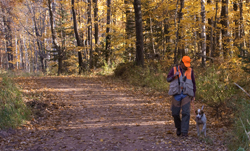Bird dogs and hidden traps

We still store the traps Jerry used when he was young. The collection includes snare, leg-hold and Conibear traps as well as the necessary chains and stakes. The large trap in front is the 220 Conibear that caught Jerry’s Brittany spaniel in 1985.
Jerry will never forget the day in 1985 when he saved the life of his first bird dog, a female Brittany spaniel. While pheasant hunting in the river bottoms of southern Minnesota, he heard a brief, odd, exhaling yelp and then nothing. The sight was horrific. His dog’s neck was caught in the jaws of a 220 Conibear trap.
After a moment of panic and a good kick of adrenaline, he worked quickly, cursing a broken safety catch on one side, and pried the trap open. She was free but not breathing and her gums and tongue had turned blue. Jerry performed mouth-to-mouth resuscitation as the final step.
Fortunately for the dog, Jerry knew about traps and CPR.
From the ages of 11 to 18 years of age, Jerry was a trapper. He used Conibear (although never as large as a 220), snare and leg hold traps, matching trap to quarry—whether fox, raccoon, mink, beaver or muskrat. As required by law, he walked his trap lines every day during the season with a wicker pack basket on his back and gained valuable knowledge about the intricate workings of many kinds and sizes of traps.
Even though Jerry and I haven’t known of any dogs—either ours or dogs owned by friends and clients—killed in traps, we do know of some who were injured. But dogs do die as Doug Smith, outdoor writer for the Twin Cities-based Star Tribune, reported in a piece on January 15, 2013.
http://www.startribune.com/sports/outdoors/187053051.html
We think it behooves all hunters to become familiar with the types of traps they might encounter and how to free a trapped animal.
Snare Trap
Cut the wire (Carry a Leatherman or other tool capable of cutting wire.)
Leg-hold Trap
Step on the spring(s) and the trap will release.
Conibear, also called Body Grip Trap
Print the instructions from the website below and carry with you, along with heavy-duty zip ties as specified at the bottom of the document.
http://www.mntrappers.org/_fileCabinet//bodygrip.pdf
Another life-saving technique that worked for Jerry and his Brittany spaniel is CPR. In addition to resuscitating a dog from a trap, CPR can be useful in other emergency situations.
http://depts.washington.edu/learncpr/cat_dog.html
Many thanks to Chris Bye for the idea of this post.




